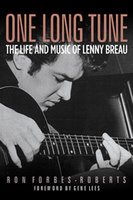
One Long Tune: The Life and Music of Lenny Breau
By Ron Forbes-Roberts
University of North Texas Press
1-57441-210-8
The early chapters of most biographies are a struggle to read, regardless of the prose style of the biographer, because only the most passionate enthusiasts will be interested in the youthful years of the subject. However, Forbes-Roberts had an advantage in Lenny Breau, a jazz guitarist who was playing so early, at such a highly accomplished level, that the story of his artistic development begins well before Breau graduates from high school. It is a musical journey Forbes-Roberts documents quite well in One Long Tune: the Life and Music of Lenny Breau.
Born to professional country singers who toured New England and Canada as Hal Lone Pine and Betty Cody, Breau’s earliest professional experience was as part of their country & western review. Although celebrated as jazz soloist who adapted the innovations of pianist Bill Evans from the piano to the guitar, country sounds who always be a part of Breau’s palette. Indeed, the arguably most important association of Breau’s life, and the greatest influence on his stylistic development was country legend Chet Atkins. Forbes-Roberts writes:
“The stable, straight-laced, and generous older man would become the empathetic, accepting father to Lenny Breau the Hal Lone Pine had not been. Motivated by a deep affection and respect for Lenny, Atkins did all he could to guide Lenny professionally and personally.” (p. 119)
One of the many virtues of Forbes-Roberts’ biography is that he clearly and persuasively explains the innovative techniques Breau, and Atkins before him, brought to the guitar. In doing so, he dispels any lingering preconceived notions of jazz and country artists as primitive, unschooled, and simply intuitive musicians. Breau and Atkins were advanced musicians, who gave tremendous thought to their art, and honed their playing through dedicated practice.
Atkins would produce Breau’s first two albums for RCA. Despite the promise they showed, Breau’s career was often undermined by his personal demons, particularly his drug and alcohol addiction. Breau continued to pursue music with a religious fervor, but his chaotic marriage to his abusive second wife, Jewell, further acerbated problems.
Tragically, on August 12, 1984, Breau was found strangled in the roof-top pool of his low-rent L.A. apartment building. To his credit again, Forbes-Roberts doesn’t pull any punches writing about Breau’s murder and LAPD detectives Bird and Aldahl’s suspicion of Jewel Breau:
“Her well-documented history of spousal abuse and flaws in her testimony (which remain confidential in the unclosed case) convinced Bird and Aldahl of her guilt and they requested that she submit to a polygraph test. Jewel agreed initially, but balked at the last moment and refused to have further contact with the police except through her lawyer. Bird told this author that her refusal to be tested confirmed his belief that she was complicit in her husband’s murder.” (p. 271)
Jewel Breau, now remarried as Jewel Flowers, refused to be interviewed by Forbes-Roberts. She was never charged because “the detectives decided that the Los Angeles District Attorney’s office would not have a strong enough case to bring her to trial.”
One Long Tune is a great music biography. Fellow guitarist Forbes-Roberts writes about Breau’s technical facility in such great detail, some readers may find themselves skimming these passages. However, rather than tossing around over-used terms like “genius,” Forbes-Roberts makes a well-reasoned, credible case for Breau greatness. Over all, the book is highly readable. If nothing else, it will broaden the appreciation for the music of Lenny Breau, but one can also hope it will lead someone to take another look at his murder investigation.